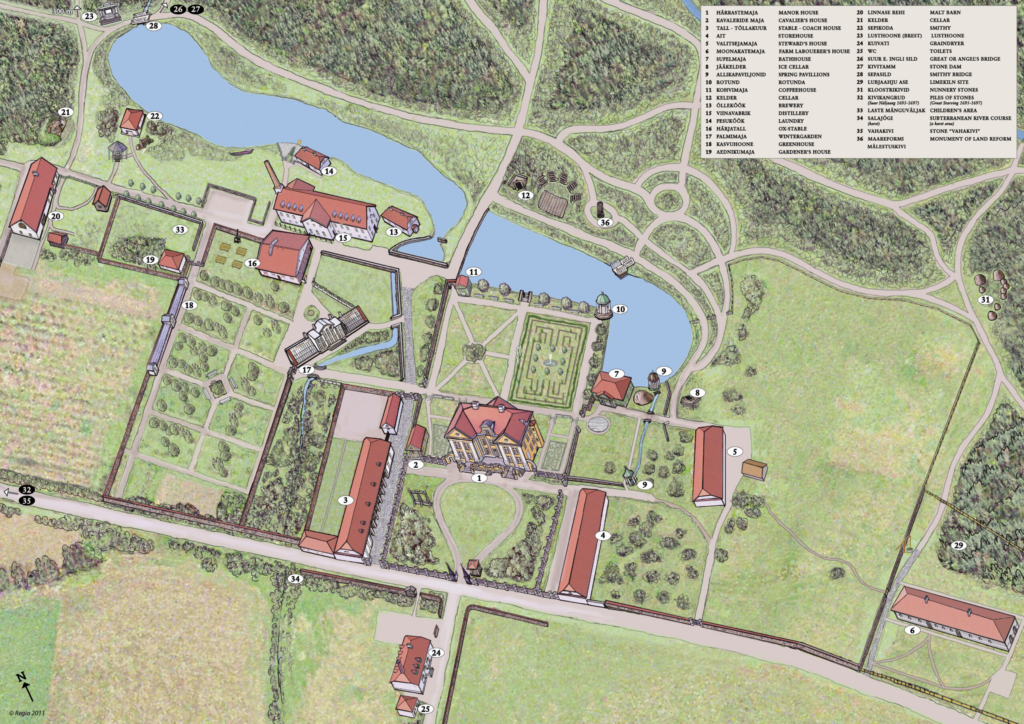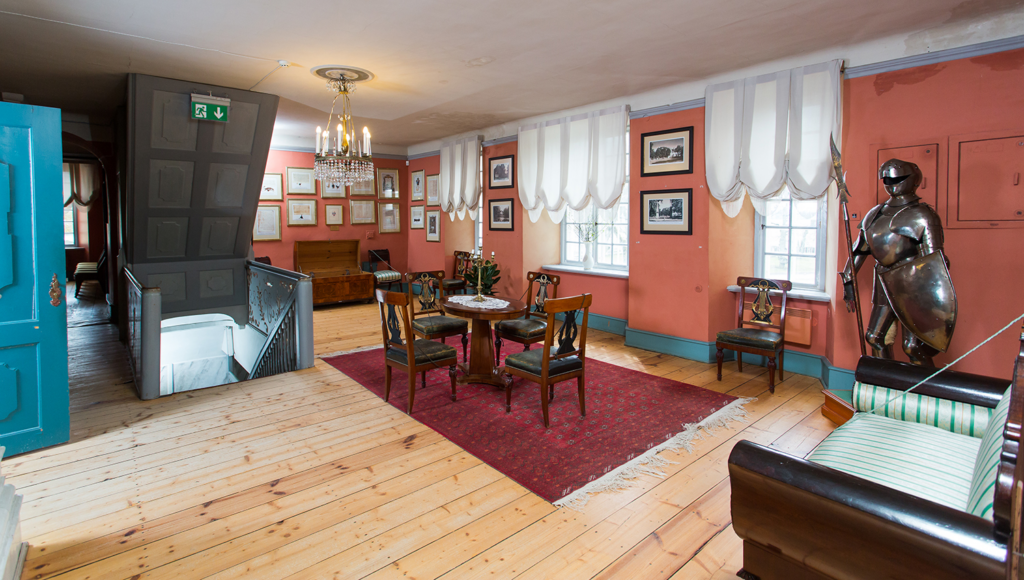Manor House

MANOR HOUSE
FLOOR 1
You are in the centre of the manor complex, in a double baroque manor house, which was used as the von der Pahlen family house.
READ MORE
History
Little is known about the architecture of the manor house before the 18th century, but it was probably a wooden building with a simpler mantel chimney, which was destroyed in the wars that hit Estonia.
Construction of the manor complex began during the time of Gustav Christian von der Pahlen. However, they did not get very far with the construction work as Estonia was hit by a great famine (1695-1697) and the Great Northern War soon began.
In 1710, Palmse was hit by a plague epidemic that killed more than half of Palmse’s population.
Construction
Major construction work began in the late 1720s and the building reached its modern shape in 1785.
The next major stage in the development of the building began when Carl Magnus von der Pahlen became the owner: the existing house was rebuilt and the wing (demolished in the 1930s) was completed.
Furniture
The current furniture did not belong to the von der Pahlen family (except for the ‘ancestral bench’ in the hall and the chair in the general’s room on the second floor) but was purchased both as sets and as individual items from various parts in Estonia.
VESTIBULE
Palace mirror
READ MORE
Neo-Rococo, 2nd half of the 19th century.
Richly framed, wood carving covered with gold leaf.
Grandfather clock
READ MORE
Classicist features, 18th century, England.
In addition to the hour and minute hands on the clock face, the clock has second and date dials and an on/off strike mechanism.
This type of clock started to be called a ‘grandfather clock’ after the English song “My Grandfather’s Clock”.
THE MANOR’S OFFICE
READ MORE
The office was originally used as a visiting room.
Today, there is an exhibition depicting the construction of the Baltic Railway.
Alexander von der Pahlen, founder of the Baltic Railway
Alexander (1820-1895) was the only son of Carl Magnus von der Pahlen, who became the owner of Palmse Manor in 1863.
In addition to Palmse, he owned the manors of Vaida, Aruvalla and Arbavere.
Alexander von der Pahlen was a high-ranking politician and in 1852 he became the district ambassador of Harju County for ten years, and later a county and state councillor.
From 1862-1868, he was the leader of the Estonian Knighthood.
As the president of the Baltic Railway Society, he dedicated himself to the establishment of the Baltic Railway, and in 1870 a railway line was opened between St. Petersburg, Tallinn and Paldiski.
He was awarded the title of honorary citizen of Tallinn for this.
In addition to government work, he was very interested in the natural sciences, especially geology.
He was married to Olga von Grote (1826-1888) and had three sons and six daughters.
Laidoner’s desk
READ MORE
Late 19th century, Tallinn.
Light oak.
Formerly owned by General Johan Laidoner.
Cabinet
READ MORE
Neo-Renaissance, late 19th century, Tartu.
Oak
Smoking table
LOE SIIT
Late 19th century.
Reed legs.
GREEN SALON
READ MORE
The salon was used as a salon belonging to the visiting room of the lord of the manor, where he invited his guests to talk.
Grand piano
READ MORE
1840, manufacturer WIRTH.
Walnut.
The piano has a special proportion to the general shape.
The pedal frame is designed with a lyre motif, with a scallop motif at the bottom.
The ancestral gallery of the von der Pahlen family
READ MORE
Gustav Christian von der Pahlen (1648-1736) and Margarethe Dorothea, born Metztacken (1656-1681)
Arend Dietrich I (1675-1710) and Margaretha Charlotte, born Wachtmeister (1686-1712)
Arend Ditrich II (1707-1753) and Magdalena Elisabeth, born von Derfelden (1710-1793)
Hans (1740-1817) and Beate Ulrica Sophia, born von Stenbock (1759-1845)
Carl Magnus (1779-1863) and his first wife Elisabeth (Betsy), born von Essen (1797-1820), and his second wife Katharina (Kitty), born Arvelius (1800-1869)
Alexander (1820-1895) and Olga Frederike Agnes Isabella, born von Grote (1826-1888)
Magnus Hans Alexis (1850-1925) and Lubi (Aimee), born Stael von Holstein (1857-1902)
Gustav Christian (1883-1914)
Gustav Christian’s wife Katharina Marie Natalie, born von Buxhoeveden (1887-1938) and sons Hans Georg Alexis Alexander (1911-1979) and Dietrich Peter Arend (1913-1964)
Palmse sofa or “Ancestors’ bench” (Ahnenbank) Late 18th century.
READ MORE
Arend Dietrich von der Pahlen (1878-1945) married Gerta Offermann in Rhineland and took the bench with him from Palmse.
After Arend Dietrich’s death, the widow made sure that the bench was returned to the Pahlen family.
In 2010, the von der Pahlen family decided to return the bench to Palmse Manor again.
GREY SALONG
READ MORE
The salon is furnished with Russian Biedermeier furniture made of Karelian birch from the first half of the 19th century.
There used to be a library room here.
Carl Timoleon von Neff, Estonian Woman with Child
READ MORE
Oil/canvas.
Copy. Original 1850s, located in the Art Museum of Estonia.
The panorama of Rakvere with the ruins of the fortress are in the background of the painting.
Carl Timoleon von Neff, Portrait of Singer Gertrud Elisabeth Mara
READ MORE
Oil.
Copy. Original 1828, located in the Art Museum of Estonia.
Carl Timoleon von Neff, Portrait of a Woman
READ MORE
Oil.
Copy. Original located in the Art Museum of Estonia.
Carl Timoleon von Neff
READ MORE
1804-1876.
Well-known Baltic-German artist, landlord of Muuga (Münkenhof) and Piira (Piera).
C. T. von Neff was born as an illegitimate child, but due to his talent and productivity as an artist he achieved the rank of a nobleman and secret adviser.
He was a member of the Imperial Academy of Arts.
In 1838, he married the daughter of the landlord Luise Auguste von Kaulbars (1804-1882) in Mõdriku, with whom he had two children.
The last years of his life were spent constructing the buildings of Muuga Manor and installing the art collection there.
HALL
READ MORE
This is the most representative room of the manor, where guests were received and receptions, meals and balls organised.
Seating garniture
READ MORE
Middle of the 19th century.
Mirror
READ MORE
Empire, 1820.
A unique pier mirror made in Estonia.
The curved surface of the plinth is special.
The mirror hinge is above, the legs resemble a seal’s paw.
The so-called mirror of the psyche.
Laidoner’s mirror
READ MORE
Empire, 1st half of the 19th century.
The mirror moves on the side hinges inside the circular frame made up of the base frame, pillars and cornice.
This so-called mirror of the psyche was used in a bedroom of Viimsi manor and belonged to Johan Laidoner.
The mirror belonged to a set with a sofa and six armchairs.
Pedestal
READ MORE
Empire, 19th century.
Cylindrical, stained birch as a base material, covered with thick mahogany veneer, beautiful wood cut.
Sculpture, Amandus Adamson, Listener to the Sounds of the Sea
READ MORE
1904.
A. Adamson (1855-1929) was an Estonian sculptor, an academic and one of the founders of Estonian national art.
One of his best-known works is the Russalka Monument (1902) in Tallinn.
Sculpture, Étienne Maurice Falconet, Bather
READ MORE
Copy.
Original 1757, located in the Louvre.
The sculpture depicts goddess of beauty and love Aphrodite and a seashell brought to her by seabirds so that she could move on the water.
The Aphrodite theme was very popular in 18th-century French art.
One of Falconet’s best-known works is the riding monument of Peter I ‘The Bronze Horseman’ in St. Petersburg.
Vladimir Makovsky, Father-in-law
READ MORE
Oil/canvas, 1888.
Vladimir Yegorovich Makovsky
1846-1920.
His father, Yegor Ivanovich Makovsky, was an amateur artist and art collector, one of the founders of the Moscow Art School.
V. J. Makovsky began his art studies at a young age under Vasily Andreevich Tropinin.
From 1861-1869, he studied at the Moscow Art School under Sergei Konstantinovich Zaryanko.
He was a member of the Imperial Academy of Arts, a professor at the Moscow School of Art and the rector of the preparatory school of St. Petersburg Academy of Arts.
Alex Galkin, Hot Summer Day
READ MORE
Oil/canvas, 1927.
Helene von Wrangell, Landscape with Cows
READ MORE
Oil/canvas.
Helene von Wrangell, Birches
READ MORE
Oil/canvas.
Baroness Helene (Jelena Karlovna) von Wrangell
READ MORE
1835-1906.
Her father, Karl Michael von Wrangell (1794-1874), was the landlord of Kohila, and her mother, Emilie Eleonore Cölestine (1811-1881, born Schafnagel), was from Ukraine.
Helene von Wrangell loved to portray the life and animals of peasants and dabbled in painting landscapes.
Her paintings can be found at KUMU, Tretyakov Gallery in Moscow and Riga Art Museum.
She was a member of various art associations in both Moscow and St. Petersburg, including a founding member of the first ladies’ art circle from 1882.
Rufin (Rufim) Gavrilovich Sudkovsky, Calm Waters
READ MORE
Oil/canvas.
The painting is owned by Baron von Stackelberg
Ludwig Thiersch, unknown portrait
READ MORE
Oil/canvas, 1863.
BLUE SALON
READ MORE
The room that belonged to the hall was used as a music salon for the lady of the manor.
Both the lady of the manor and her daughters were very educated.
They knew foreign languages and were interested in reading, crafts and making music.
Emma-style upholstered furniture set
READ MORE
Emma-style furniture got its name from Finland and was very common in manors in the second half of the 19th century.
Such objects were first used at the 1851 World’s Fair held in London for Neo-Rococo interiors to achieve cloy comfort.
Such furniture was used in groups between the main furniture in the room.
Usually, this furniture was completely covered with upholstery and fabric.
The object was decorated with long fringe, tassels and cord decorations.
Green, purple or red plush, velvet or strong cotton printed patterned fabric was used as a cover.
Olga Julie von der Pahlen, Lilacs
READ MORE
Oil/canvas.
Original painting.
Olga Julie von der Pahlen’s drawing album
READ MORE
The album contains many drawings and hand exercises – mainly nature views, still lifes and illustrations of fairy tales from 1872-1877.
Most of the drawings are visible on the walls.
Olga Julie von der Pahlen
READ MORE
1856-1919.
Olga’s grandfather Arendt Dietrich von der Pahlen was born in Palmse Manor.
Olga studied art with Franz Teppen in the 1880s.
Her paintings were exhibited in several art exhibitions both in Tallinn and Tartu.
DINING ROOM
READ MORE
Eating habits and table customs differed from family to family.
In the morning, the adults did not eat much, there was no set mealtime.
Everything changed when hosting guests.
An exquisite and varied menu was the pride of the landlords and therefore more attention was paid to culinary arts.
Good chefs were highly valued and were often sent abroad to educate themselves.
People say that as the Kitchen Mama and Papa got older, they received lifetime dependency and beautiful iron crosses in the cemetery from the manor.
It is known that in the middle of the 19th century the chef of Palmse Manor was Eru Priidik.
The festive menu of the 19th century was very diverse and the meal consisted of several courses with seafood, venison, beef, fruit and vegetables.
Luxury cupboard – the oldest piece of furniture in Palmse
READ MORE
Renaissance, 1614, the Netherlands.
Oak.
Raised wood flow with intarsia and metal.
Frisian flower vine with fantastic animals with human heads.
The upper part of the plaques depicts Adam and Eve and the lower part ancient Roman savateurs Cocles and Torquato.
The cabinet is an extraordinary example of luxurious palace furniture, which represents the excellence of contemporary intarsia art.
The frame and legs are made of black-stained wood, which must imitate ebony.
The pillars are in the Tuscan order, but the ‘winged’ gauze volutes predict the beginning of the Baroque style.
Detachable so-called centipede dining table
READ MORE
Neo-Rococo, 1st half of the 19th century, Estonia.
Oak.
Six chairs
READ MORE
Biedermeier and Empire elements, 1st half of the 19th century, Estonia.
Coniferous wood, mahogany veneer.
High end chairs
READ MORE
Neo-Renaissance, late 19th century.
Oak.
The high carved backrest is decorated with a bas-relief plant motif ornament that ends with a mascaron – a grotesque face.
Salon table
READ MORE
Intarsia rococo table with oriental ornaments, mid-18th century, France.
You can see the features of Northern European rococo: horizontal movements and a wide ribbon ornament.
Franz Schrutek de Monte Selva, Mountain Lake
READ MORE
Oil/canvas, 1852.
Franz Schrutek von Monte Selva
1807-1861.
Schrutek, known foremost as a meritorious military man, was more of an amateur as a painter.
He was connected to Estonia primarily through his marriage – in 1851 he married Eleonore (1821-1895), daughter of Mayor of Tallinn Johann Carl Girard.
On 8 December 1861, he drowned in a boating accident near Prangli Island with his wife’s brother Edmund Girard.
MUSIC ROOM
Music machine-orchestrion
READ MORE
End of the 19th Century, St. Petersburg.
Made by Jules Henry Zimmermann.
In most cases, such music machines could be found in taverns and restaurants.
On the four interchangeable rolls, there are a total of 24 songs of dance music typical of the time.
Harmonium
READ MORE
Made by Jules Henry Zimmermann in St. Petersburg.
Four grants on the inside of the cover:
1867-1878
White seating
READ MORE
Louis XVI style, early classicism, 1770-1790.
The seating furniture with lyres was ordered for the music salon.
Copper engraving following William Redmore Bigg’s painting, Saturday Day. Return from labor.
READ MORE
1795.
W. R. Bigg (1755-828) was an English artist, a member of the Royal British Academy.
He loved to paint portraits, children and village environments.
Console table along the wall
READ MORE
Mid-19th century, Estonia.
Scarce decor, white copper band around the edges of the plate (known as Jakob-style in Russia), deep red polished mahogany surface inherent to Late Classicism.
A small brass rosette at the junction of the foot, which is very typical of Estonian classicism.

MANOR HOUSE
FLOOR 2
You are in the centre of the manor complex, in a double baroque manor house, which was used as the von der Pahlen family house.
LOE SIIT
History
Little is known about the architecture of the manor house before the 18th century, but it was probably a wooden building with a simpler mantel chimney, which was destroyed in the wars that hit Estonia.
Construction of the manor complex began during the time of Gustav Christian von der Pahlen. However, they did not get very far with the construction work as Estonia was hit by a great famine (1695-1697) and the Great Northern War soon began.
In 1710, Palmse was hit by a plague epidemic that killed more than half of Palmse’s population.
Construction
Major construction work began in the late 1720s and the building reached its modern shape in 1785.
The next major stage in the development of the building began when Carl Magnus von der Pahlen became the owner: the existing house was rebuilt and the wing (demolished in the 1930s) was completed.
Furniture
The current furniture did not belong to the von der Pahlen family (except for the ‘ancestral bench’ in the hall and the chair in the general’s room on the second floor) but was purchased both as sets and as individual items from various parts in Estonia.
UPPER STAIRCASE
LOE SIIT
On the stair barrier, you will find the monogram of the manor house builder Hans von der Pahlen and the end date of the house reconstruction in 1785.
On the opposite barrier, you will see important symbols of LNP and 1985 – Lahemaa National Park opened the restored manor to visitors 200 years later.
The walls have materials introducing the history of Palmse Manor, including incredible photos of the manor before restoration.
Bridal chest
READ MORE
Rococo, 1741.
On the chest, you can find the initials of the von Rennenkampff’s of Baltic-German origin and the year of completion ANNO 1741.
The chest may come from Estonia because the local guilds ensured high quality.
RED SALON
Porcelain chandelier
READ MORE
2nd half of the 19th century.
Dresden porcelain.
Estonian toilet dresser with mirrors
READ MORE
Biedermeier, 1st half of the 19th century, Estonia.
The rich wood cut refers to 1840 when the experimental period began.
Below you can see the lion paw motif again.
“Beautiful Estonian work, simple and cool, as a classicist object must be.”
L. Pärtelpoeg, interior architect and pedagogue
ROCOCO SALON
Seating garniture
READ MORE
Neo-Rococo, 2nd half of the 19th century, Tartu or St. Petersburg.
During the first Republic of Estonia, the set belonged to the Estonian Embassy in Finland.
Corner cabinet with mirrors
READ MORE
Neo-Rococo, 2nd half of the 19th century.
Walnut.
Originates from Kohala manor.
Gilded table
READ MORE
Rococo, late 18th century.
Originates from the city apartment of Richard Sagrits.
Sagrits’ tempera painting under a glass plate from 1965.
K. P. Rubens, Sleeping Beauties
READ MORE
Oil/canvas, 1907
BEDROOM
Bedroom furniture
READ MORE
Beginning of the 19th century.
The bed and bedside tables originate from Keila-Joa Manor, which belonged to the Volkonski’s.
LIBRARY
Exhibition ‘Palmse Pahlens in the book mirror’
READ MORE
Libraries were an integral part of manor culture, but only a few have survived in whole or partly – most of them were destroyed by distributions and allocations due to the Baltic-Germans leaving Estonia in the early and mid-20th century.
In the 1940s and 1950s, the remains of the collections were nationalised and distributed among museums and libraries.
The Pahlen family library was fortunately preserved in the reserve collection of the Tallinn University Academic Library.
The library has been back in Palmse since spring 2019.
There are 2708 books and prints in the Pahlen library.
The library allows you to draw conclusions on the diversity of reading materials, the family’s economic situation and intellectual life.
Many of the books are Latin works on economics, history, medicine, geography and also politics.
There is also a compulsory resident in the libraries of noble families – Latin grammar.
In addition, there are works in German and French, even one in Dutch.
Unfortunately, it is not known exactly where the library room was located in Palmse Manor and its location probably changed over several reconstructions.
Cabinet from Sagadi manor
READ MORE
Baroque, mid-18th century, Estonia.
Alder.
According to legend, Baron von Fock of Sagadi donated this cabinet to Esku Chapel.
Folding table
READ MORE
Biedermeier, 1st half of the 19th century.
Extendable round ‘hundred-legged’ table for up to 24 people.
The table could also be used as a semi-circular table situated by two walls.
GENERAL’S ROOM ANTECHAMBER
Card game table
READ MORE
Neo-Rococo, 2nd half of the 19th century, France.
Mainly rosewood.
The high-quality card table, which opens like an envelope, is decorated with an intarsia technique combining wood species.
Wood plywood, textiles, gilded bronze details have been used.
GENERAL’S ROOM
Chair from Ilumäe Church – lord of the manor’s personal
READ MORE
Empire, 1827.
Wood, leather.
The elbow chairs were commissioned by Baron Carl Magnus von der Pahlen for the gentlemen seats in the new chapel of Ilumäe.
Cabinet furniture
READ MORE
Late Classicism (Jacob style), from the beginning of the 19th century.
St. Petersburg.
The table is designed to stand in the middle of the room – the high backside is properly finished.
The doors of the drawers are decorated with the sun motifs of Louis XVI.
The table was brought to Estonia from St. Petersburg in 1917 by a Russian merchant.
Map of Palmse manor and manor economy
READ MORE
Copy, 2019.
Original in the Museums of Virumaa Foundation collection.
The original map drawn by land surveyor C. Jürgens in 1859-1864 shows the entire territory that belonged to the manor – 10,820 hectares.
The map was probably commissioned by Carl Magnus von der Pahlen but was not finished until after his death.
The map was found in the attic of the manor house when replacing the roof in the 1970s.
From 2002-2018, it hung right here on the wall of the General’s room, but due to unsuitable conditions, the map needed to be preserved.
Palmse Manor as the centre of local life
The manor seen on the map was not only the residence of the gentlefolk.
Above all, it was a functioning economic unit – the complex consisted of around twenty buildings and the manor was one of the largest at the end of the 19th century.
There were a little over 10,000 hectares of land, most of it forest and bog.
There were around 900 peasants.
Although the landlords of Palmse also held important positions, a large part of the income came from the economy of the manor.
The main income came from the rental of cattle manors and farms, the sale of firewood and tables, the brick industry and the sale of raw alcohol.
In addition to large companies, the manor had its own dairy, weaving workshop, limestone quarry and lime and tar kilns, the products of which were used for their own purposes.
The Palmse brickyard, which produced both bricks and roof tiles, existed as early as 1780.
A brick factory was built in Võsu in 1868


